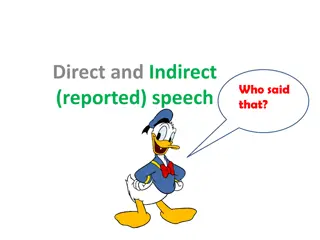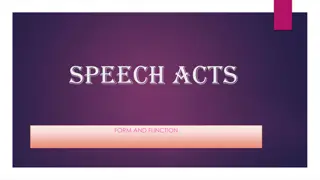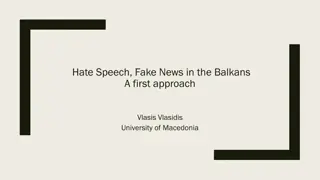Understanding Imagery and Figures of Speech
Language conveys meaning through imagery, using comparisons like similes and metaphors. Figures of speech such as parables and allegories help convey deeper ideas through storytelling. Explore the power of symbolism in literature and everyday life.
Download Presentation

Please find below an Image/Link to download the presentation.
The content on the website is provided AS IS for your information and personal use only. It may not be sold, licensed, or shared on other websites without obtaining consent from the author. Download presentation by click this link. If you encounter any issues during the download, it is possible that the publisher has removed the file from their server.
E N D
Presentation Transcript
Similarity Contrariety Affiliation Imagination
Images It is a language that convey meaning through 'painted words' or creating 'mental pictures.' The words that enable us to covey these 'mental pictures' are what we call imagery. This simply means that things and issues in life are better understood when compared or contrasted with other things. This idea of comparison heightens or diminishes the mental pictures or images being expressed. Example: A: He is a man. B: He is a guy.
Figures of Similitude The figures of speech listed here attempt to compare two or more objects or ideas based on their similarity with certain qualities they possess. Simile, metaphor, parable, allegory, fable, symbol, antonomasia,
Simile This is a comparison between the qualities or attributes of two things. This type of comparison is normally introduced with words like 'as' or 'like.' For example: Great water drops are dribbling/ Falling like orange or mango ('Night Rain'by J.P.Clark)
Metaphor This is a comparison of the qualities or attributes of two things that are not similar. Metaphor operates on the principle of equation. In other words in metaphor the identity of one thing is transferred to another in order to create images. For example: Nefertiti is a rose. In this example, the qualities of rose are compared with that of a woman. Naett. coin of gold, shining coal, you my night, my sun! (from L.S. Senghor's'/ will Pronounce your name)
Parable & Allegory A parable Is a short story told with a view to drawing the attention of the hearer to its comparative idea. Allegory: A long extended comparison in which one subject is described in great details but signifies another meaning.
Fable This is very similar to allegory. The major difference is that the characters are often animals or supernatural beings. Furthermore the story is normally told with a clear moral lesson in mind. A popular example is George Orwell's Animal Farm which is supposedly a story about animals in a farm, but has the extended meaning of narrating the diverse behaviourof man in society. Symbol This is a representation of an idea(s) with certain objects or words. For instance, a red light at a road intersection becomes a symbol if it triggers off the idea of danger in the minds of drivers and pedestrians. Nevertheless if it only causes drivers to stop without putting their minds on the idea of daeger, it functions simply as a sign. When a symbol is used in literature, the purpose is to give it a meaning which goes beyond the physical representation. For example, the cross is a symbol for Christianity.
Antonomasia Antonomasia This is a figure of speech wherein the name of a well- known person, place or event is used to represent some qualities which it symbolises.
Figures of Contrareity words that suggest opposing views in meaning in order to achieve a literary effect. It is a very effective and emphatic way of making a point. Antithesis, parallel, epigram, oxymoron, paradox, climax
Antithesis Antithesis It is the repetition of grammatically similar words, phrases of opposed or contrary meaning in a sentence. This is also referred to as balanced sentence. This grammatical device may be stretched over several paragraphs. * Examples: 'While the ignorant condemn learning, the learned condemn ignorance.' 'Fair is foul, foul is fair...'
Parallel, Epigram, Oxymoron Parallel This is an extended antithesis, but a prolonged comparison that brings out the contrast between two persons or things. Example: How far that little candle throws its beam! So shines a good deed in a naughty world. Epigram This is a brief witty saying that sounds contradictory at first, but upon further investigation is found to be full of truth Example: 'More haste, less speed.' Other examples are: Afraid of death, the world dies; Afraid of love, people die Afraid of light, roses die. (Ossie Enekwe, From 'No Death at all," Broken Pots) Oxymoron This is placing close together, two words or statements that are apparently contradictory in meaning in order to achieve an effect. Example: Gentle winged butterfly With the voiceless cry by day (From Lenrie Peters' She came in silken Drapes)
Paradox Paradox This is very much like an epigram. It is a statement that seems absurd or senseless on the surface but turns out to possess some truth on a second consideration. For example let us consider these lines from William Wordsworth's 'My Heart leaps up' My heart leaps up when I behold A rainbow in the sky; So was it when my life began; . So is it now I am a man; So be it when I shall grow old, Or let me die! The Child is father of the Man; OR Did you forget justice. Do you kill me When am already dead I, who was small and strong Now am big and weak I, who was young and wise Now am old and foolish. (From 'Amadioha will answer1 by Ezenwa Ohaeto)
Climax Climax This is the arrangement of terms, words or statements to express an idea in ascending order of importance to build to a crescendo or height. Let us take a look at TERROR by Peter Onwudinjo Who can tell the terror In the flight Of the wrenched-off heads in spray, Or the grotesque stagger of the head Less trunk in flight Oh Lord how he ran! How he fell! how he slumped!
Figures of Affiliation Synecdoche, metonymy, hypallage, allusion,
Synecdoche & Metonymy Synecdoche This is a representation of one thing with its part or the whole is used to represent the part. The part used in representing the whole must be an important part and must be directly associated with it in order to bring out the full meaning of the whole. Example: All hands shall be on deck 'Hands' here represent people. Metonymy This is a representation of an object with something closely associated with it. These objects include things they are known by things they normally wear, symbol of their authority or tools of their profession. In metonymy people are replaced by the objects they are normally associated with. Example: 'Agbada has submerged this country into the depths of corruption.' 'Agbada': a metonymy for politicians.
Hypallage & Allusion Hypallage or Transferred Epithet This is a figure of speech in which the qualifying adjective is transferred from a person to a thing. From the poem 'Stanley meets Mutesa' we see the following example: The thin weary line of carriers With tattered dirty rags to cover their backs The highlighted line is an example of hypallage. It is noteworthy that it is not the 'line' that is 'weary,' but the 'carriers.' Under 'normal' sentence construction, that line should have been: 'The thin line of weary carriers.' Allusion This is a reference to some well-known events, places or persons in classical or great books like the Bible. Classical allusions are references to events in classical literature of the Greeks, Rome and some other ancient empires. She came in silken drapes And naked breasts, Veiled Artemis, seated On an eagle's nest (Lenrie Peters' She came in silken Drapes)
Figures of Imagination Personification, apostrophe, invocation, hyperbole,
Personification Personification This figure of speech is derived by giving inanimate or non- movable objects the qualities of a human being. These include attributes that human beings are endowed with or functions that animate objects can perform. Example: Cattle Egret My children gather stars Into their soft songs And woo the young moon With their teeth. The moon kisses My daughter's emerging breasts And my son's dimples. (Okotp'Bitek, From A Selection of African Poetry)
Apostrophe Apostrophe This is a direct address to person, inanimate object or being as if it is present before the addressee. Apostrophe is a kind of personification in which one talks to a non-lining thing as if it were a human being and a person who is absent at a place as if he were within hearing distance. It is a kind of address. The speaker can address an abstract concept, a non-human, a living person or a dead person as if that person is there with the speaker. Let us consider the following example: DEATH be not proud, though some have called thee Mighty and dreadful, for thou art not soe, From John Donne's Death be not Proud )
Invocation Invocation This imagery is closely related to apostrophe. In the use of invocation, a being, god or dead person is directly addressed and appealed to or told to do something for the benefit of himself/itself, or the living. For example: Okigbo Come like thunder Okigbo, Come from the soil of Africa Like only a black man can Shake the cold souls from their graves Okigbo, Shake them till the ice melts like rain Into the blooded earth. (Peter J. Bradford from Don t Let him Die)
Poetry is fun Thank You


![Prevention and Combating of Hate Crimes and Hate Speech Bill [B.9B.2018]](/thumb/60513/prevention-and-combating-of-hate-crimes-and-hate-speech-bill-b-9b-2018.jpg)




















